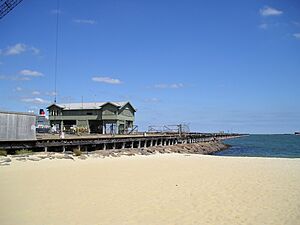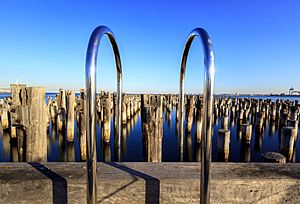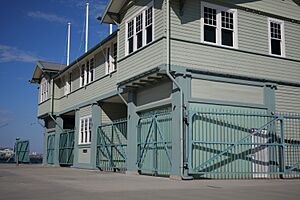Princes Pier facts for kids
Princes Pier is a very long, historic pier in Port Melbourne, Victoria, Australia. It stretches 580 meters into Port Phillip Bay. A pier is like a long walkway built out over the water. It was first called the New Railway Pier. Later, it was renamed Prince's Pier in honor of the Prince of Wales. He visited Melbourne in May 1920 and later became King Edward VIII.
Building the Pier
Princes Pier was built between 1912 and 1915. The Melbourne Harbor Trust constructed it. Its purpose was to help the nearby Station Pier handle more ships and passengers. When it was finished in 1915, it became a very important place. Many new people arriving in Australia, especially after World War II, first stepped onto land here.
The pier was more than just a walkway. It had many buildings and features. These included a gatehouse, a main terminal building, and rooms for people to use. There were also places to store goods and special railway tracks. These tracks helped move people and items directly from the ships.
Trains and Travel
From the very beginning, Princes Pier was connected to the Port Melbourne railway line. This meant trains could go right onto the pier. There were eight railway tracks on the pier itself. Four tracks ran along each side.
A special passenger train service started on May 30, 1921. These were electric suburban trains. They ran only when ships were docked at the pier. Usually, a single "swing door" train car carried passengers. However, this train service stopped in November 1930. It was not making enough money for the Victorian Railways. The overhead electric wires were taken down in 1953. The railway line was later made into a single track for moving goods.
Changes and Restoration
Over time, large shipping containers became popular. This change meant the pier was used less and less. It was closed to the public in the early 1990s because its wooden structure was in poor condition. Sadly, a fire started by squatters in the late 1990s destroyed some of the pier's buildings. In just three years leading up to 2004, there were 14 fires on the pier.
In April 2006, the government announced plans to fix the pier. The first 196 meters of the pier were fully restored. Beyond that point, the old wooden deck was removed. However, the original wooden support pillars were kept. This helped preserve the pier's history. Work began in October 2007. The restored part of the pier reopened to the public in December 2011. Now, people can enjoy walking on this historic landmark once again.




